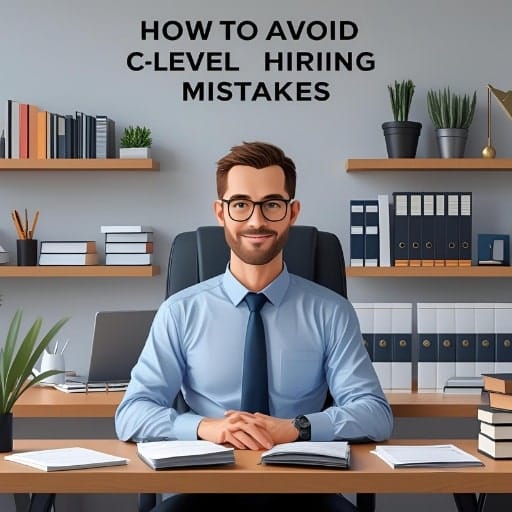Introduction: The Pain of Post-Hire Disappointment
It’s the call no board member or CEO wants to make:
“We thought we hired a game-changer. But six months in, we’re questioning everything.”
This is not a rare scenario. In fact, it’s a familiar—and expensive—mistake: a senior executive dazzles in interviews, wins over stakeholders, and says all the right things. But once in the role, they stall. The energy, clarity, and strategic vision they promised never materialize. Teams disengage. Momentum fades.
The truth? You didn’t hire a transformational leader. You hired someone who gave a transformational interview.
Here’s why this happens, how to spot it early, and what the right executive search process for transformational leaders should look like.
Pro Tip: When a new hire doesn’t match their promise, it underscores the importance of a strategic leadership recruitment process focused on verifiable track records.
1. Calculating the Cost of a Bad C-Level Hire
A poor executive hire isn’t just a dent in your budget—it’s a strategic failure.
When you’re calculating the cost of a bad C-level hire, consider:
- Base salary + bonus + equity (often $500K–$2M)
- Severance and legal costs tied to early termination
- Recruiting fees for the replacement (another 25–35% of first-year comp)
- Lost time and momentum, often 6–12 months of strategic stall
- Team attrition, especially if the leader causes friction or confusion
- Board confidence erosion, especially in public or PE-backed firms
And those are just the quantifiable costs. The real damage is often cultural: a misaligned leader erodes trust, morale, and urgency—sometimes permanently.
2. Signs a New Executive Hire Is Not the Right Fit
C-level misfires rarely implode overnight. Instead, they deteriorate gradually. Leaders and boards begin to notice subtle—but consistent—disconnects.
Here are key signs a new executive hire is not the right fit:
- Lack of follow-through on strategic initiatives they proposed
- Over-reliance on the status quo rather than driving innovation
- Failure to build trust with senior team members
- Resistance from peers or subordinates, signaling poor emotional intelligence
- Indecisiveness or weak crisis leadership under pressure
- Culture clashes—e.g., authoritative leadership in a collaborative environment
If you’re seeing two or more of these within the first 90–180 days, you’re not being impatient—you’re likely identifying a pattern.
3. Why Interview Success Doesn’t Guarantee On-the-Job Impact
So why does this happen?
Because most hiring processes over-index on performance in interviews—not the deeper qualities that define transformational leadership.
Many executives have been trained to master interviews: they rehearse success stories, deliver polished answers, and mirror the company’s values. But assessing transformational leadership during interviews requires a different approach.
What traditional interviews miss:
- Change leadership under real stress
- Track record of scaling strategy, not just executing tasks
- Authenticity and adaptability when challenged
- Ability to influence without authority
A great interviewee doesn’t always translate to a great leader—unless your assessment model is engineered to distinguish the two.
4. How to Avoid C-Level Hiring Mistakes

The solution isn’t longer interviews. It’s smarter ones—and a more sophisticated search strategy. Here’s how to avoid C-level hiring mistakes:
✅ Redefine the Role Beyond the Job Description
Don’t just list competencies. Define the mission—what the executive must transform, build, or fix within 12–24 months.
✅ Use Behavioral & Situational Interviewing
Ask about real past failures. Present ambiguous scenarios. See how they handle discomfort.
✅ Integrate 360° Cultural Mapping
Assess how the candidate aligns with your company’s values, operating style, and leadership norms.
✅ Conduct Rigorous Back-Channel Referencing
Go beyond the curated references. Talk to peers, former reports, board members. Uncover the real story.
✅ Employ Executive Assessments
Leverage psychometric tools and executive simulations to stress-test thinking, adaptability, and values.
5. Building an Executive Search Process for Transformational Leaders
At JRG Partners, we design our entire process around one core belief:
Transformational leaders leave evidence. And it’s our job to uncover it.
Here’s how our retained search process delivers better-fit leaders:
🔍 Deep Discovery and Success Blueprinting
We co-create a transformation scorecard—not just a job description—with our clients.
🧠 Strategic Capability + Leadership Judgment Assessment
We use proprietary tools to vet for executive presence, strategic foresight, and values-based decision-making.
📞 Discreet Back-Channel Referencing
Our referencing process is designed to uncover risks others miss—before you make the offer.
🧭 Cultural Compatibility Evaluation
We assess personality, conflict styles, and team dynamics to ensure alignment—not just credentials.
Because if you want someone to lead transformation, they must already have done it—ethically, strategically, and sustainably.
This disconnect between interview and reality is devastating, ultimately contributing to the fact that your last C-suite hire resigned within a year, costing the company millions.
Final Thought: Hire for Impact, Not Just Impressions
The disappointment of hiring a leader who looked perfect on paper—but faltered in practice—is deeply familiar to boards and CEOs. But it doesn’t have to be inevitable.
A smarter process—one built for assessing transformational leadership during interviews and beyond—can protect your strategy, culture, and future.
Don’t just hire who interviews well. Hire the leader who can actually deliver change.
Facing doubts about a recent hire—or planning a mission-critical executive search?
Talk to JRG Partners. Let’s ensure your next executive hire doesn’t just look like a transformational leader—but leads like one.


